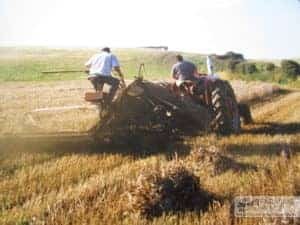Mike Henderson on Soils
Some of the real heavy clay lands that they’ve got down the way here can be a nightmare to do a decent job. If you try and plough them, if it’s too wet you batter it and you do more damage with your tyres than you want to and you can’t get it to turn over at a stand on end.
We had it one year, a good many years ago, it had been quite wet and my then boss decided we would plough everything before we started drilling in the autumn. So, we ploughed and the heavy land didn’t turn over nice, it just stood on end so you know it had great gaps between each furrow, you could see down to the furrow floor and we got through the ploughing and then we had a really prolonged period of cold northerly winds and it baked that lot out and we had a tremendous job to try and get a tilth.
We’d go through it with a power harrow. His idea was we would plough it … because he’d been persuaded to go in to combination drills, power harrow with a piggy-back drill on top, one pass, that was his thing. “You’ll do that in one pass.” Well it didn’t work. We were having to lift the cultors out the ground and go and do the heavy blocks and we’d do ’em three or four times, cross them, you know just trying to beat ’em into submission and you’d end up knocking a coconut into an orange size into an apple size, into …something like that and that was the best you could get. But because it was so lumpy and that, once you drilled it, you rolled it, you put the pre-emergent sprays on and all that. Anything that was nice light soil came up beautiful, but all those heavy patches you had nothing.
Get the odd bit of weed grow through and of course in the spring it was full of weeds, thistles, whatever. But on that farm you had everything ranging from yellow sand to red clay that you could have dug out and made house bricks out of. And I think the Island is sort of …soil type is typified don’t they call it Bembridge Marl, I think? But yes, I mean over where I work now, over at Niton and Whitwell, there’s a lot more flint and some of the soil is very grey and it goes down like a powder.
When you plough it and you work it down and I rolled some last autumn and I couldn’t see where I was going with a following wind there was so much dust coming off and it was so light and fluffy, that even after that 40 feet set of rollers had gone over, I’d get out and walk behind it and you’d still sink in with your feet about that far. Some of the land is peculiar, but I got used to the various types down at Wellow Manor there and we learnt over the years the fields that you needed to cultivate early and drill early in the autumn, because if it got wet, the best option was to leave it until the spring but then that meant you had winter wheat seed carried over and it didn’t always do so well the following year ‘cos of the dressings that were on it, so you know over time we learnt although I was talking to one of the lads that works down there coincidentally yesterday and I said, “Have you got Institute done yet?” “No” I said, “Well you should have that in first.”
Nothing like telling them what to do when you no longer work there, but that’s the experience that I learnt … but yes, you go through the Arreton valley it’s all this lovely sandy soil that ploughs up beautiful. It can be a nightmare if it gets wet obviously, sand does tend to be a bit difficult if it’s really wet, but they can get it turned over and get a good control of weed seeds. If you can turn it over and completely bury the weed seeds the vast majority don’t survive.
Whereas the heavier lands, I think people tend to go more for minimal cultivation, just work the top two or three inches. So, yeah, there is a considerable variation of land across the Island and there’s considerable variation across the land on most farms. I expect it’s the same country wide. But you learn the best way of dealing with it and by and large, you know it works out pretty well. It’s a case of learning through your mistakes, or learning from experience so there’s a considerable variation of land on the Island and every farm is different and they all have their own ways of doing things.
The way that works for them so that’s about it really, dirts dirt but there are different sorts of dirt (laughs). Easy dirt and hard dirt (laughs)







